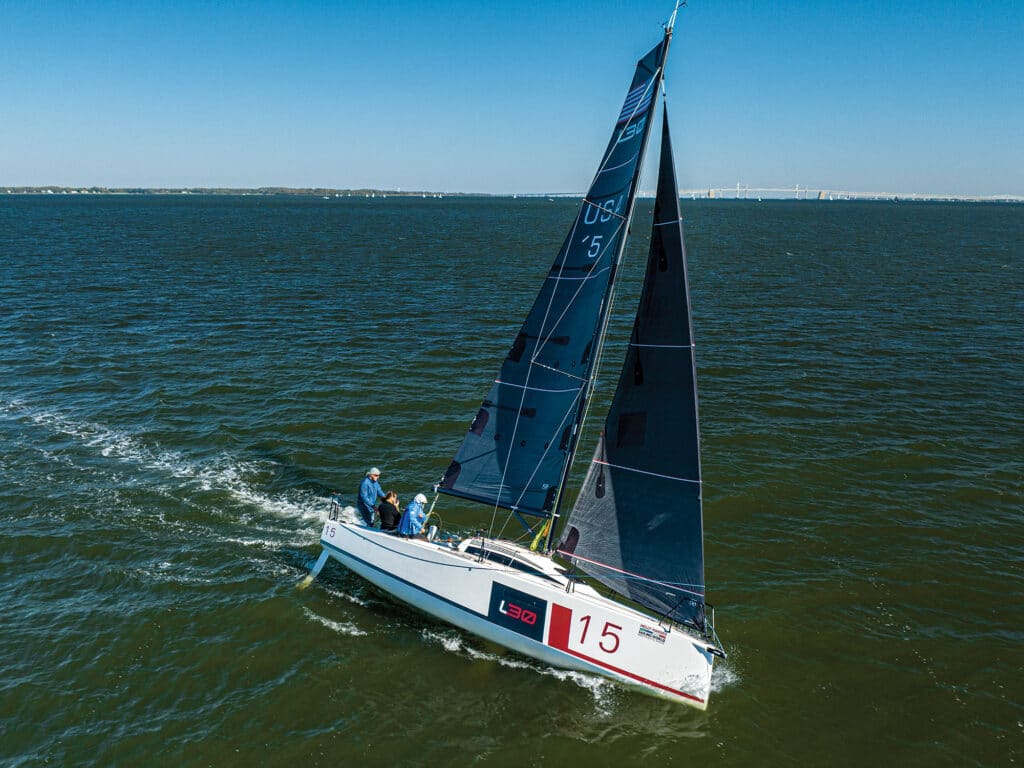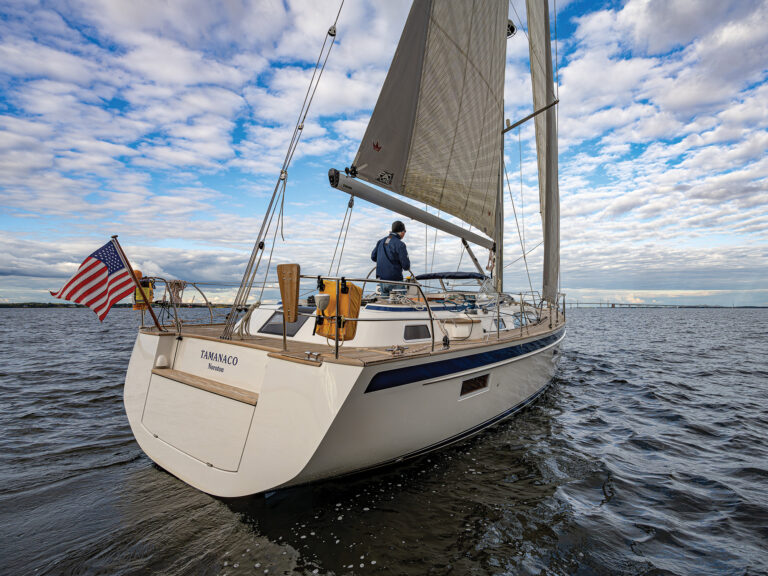
Amid the fleet of 17 new sailboats being introduced to North American sailors at the United States Sailboat Show in Annapolis, Maryland, the Ukrainian-built L30—a dual-purpose racer/pocket cruiser—stood out for a variety of reasons.
First of all, at 31 feet, 5 inches length overall, it was the smallest boat that Cruising World’s Boat of the Year team inspected. It was the least expensive too, with a base price of $160,000, well below the cost of other vessels in its size range.
And then there was the fact that it was the only boat that the judges were unable to assess with our usual in-water, dockside inspection. Instead, we trudged past tents and across asphalt, and climbed a short flight of stairs to board the boat, which was sitting high and dry on its trailer, parked alongside the show’s perimeter fence. That’s where we met the L30’s importer and chief cheerleader, Alexander Ivanov, an energized Ukrainian sailor, who now hails from the Pacific Northwest but travels the country, regatta by regatta and boat show by boat show, to help build the L30 Class one-design racing fleet and promote the boat’s attributes as a sail-training vessel and family cruiser.
Several days later, we met Ivanov again, this time aboard the L30 out on the water, where we had a southwest breeze in the 10-to-15-knot range. As soon as we’d finished our motoring drills, we hoisted sails. Ivanov moved quickly from winch to winch and line clutch to line clutch, demonstrating the many micro adjustments that could be made by tweaking a multicolor array of sail-control lines.
Hard on the breeze, the L30 stood up to its canvas well and bounded through the chop. With a displacement-length ratio of just 76 (the lowest of the new-boat fleet) and a sail-area-displacement ratio of 32.2 (the largest), there was plenty of horsepower to play with. And, thanks to relatively high sides, the ride was for the most part dry as we cruised along at 7 knots or better.
Later, with the retractable bowsprit extended and the code zero filled—nearly doubling the sail area—well, let’s just say the experience was downright sporty.
The concept behind the L30 was developed by a fellow Ukrainian, Olympic silver medalist and 49er Class World Champion Rodion Luka, who worked with designer Andrej Justin to come up with a relatively affordable keelboat with a design brief that includes offshore performance, trailerability, and ease of use. First launched several years ago in Europe, the L30 is relatively new to North America. Last year, Luka and Ivanov promoted both the boat and the L30 Class at several of the Helly Hansen-Sailing World Regattas organized by CW’s sister publication. Boats were towed from venue to venue and were available for charter, letting US sailors trade tacks and jibes with a handful of L30 Class European teams. Plans are to be at regattas again this year as the class expands. Incredibly, boats continue to be built in Ukraine and exported, despite the ongoing war with Russia. The design is also licensed to the Code Yachts shipyard in Hungary.
The L30 is a relatively narrow boat by today’s standards. Its beam of 8 feet, 4 inches allows it to be towed over the highway on a trailer or shipped via a container.
As you might expect with a sporty daysailer, the cockpit is large and open, providing room for a crew of four or five to work, though the boat is also intended for singlehanded and doublehanded events. Twin wheels are located well aft, near the open transom. The boat sports dual rudders, each mounted in a cassette on the stern. The cockpit has no seats, so underway, one sits on the sole or side deck using removable soft seats.
In race mode, the L30 is rigged with a square-top main and armed with running backstays for when the breeze is on. It carries a quiver of jibs to match upwind conditions, plus the aforementioned large, powerful code zero for reaching and running. In cruising mode, running backstays can be fixed along the mast. As I said, sail-control lines are abundant. But for cruising or sail-training purposes, sheets and sheet leads can be simplified, the main can be reefed, and the working jib is flown on a roller furler, so it can be easily set and doused.
The boat we saw in Annapolis had a carbon-fiber mast and boom. The mast is stepped on the cabin top using a tabernacle. We did not see it being set up, but we were told that the boat can be rigged and ready to launch in a couple of hours. Once in the water, the 6-foot-2-inch lifting keel is raised and lowered with a winch on the cabin top. With the foil up, the boat draws just under 2 feet, and it can be launched by crane or on a ramp.
Below, the L30 sports a minimalist and workable interior. Looking through the companionway, one peers directly into a head compartment, offset to starboard. A pair of bunks stretches aft under the cockpit, with a sink and counter amidships to port. There was no stove on the boat we sailed, but it would be easy to add a small cooktop. Forward of the head and sink, space opens up to a pleasant V-berth and sitting area.
The base price of $160,000 doesn’t include sails or a trailer. The boat in Annapolis, fitted out with rod rigging, nke electronics, Antal winches and a full suite of UK sails, had a sticker price of $210,000, still less than any of the competitors.
The L30’s hull and deck are infused using vinylester resin and cored with foam. The boat we saw in Annapolis was powered by a 15 hp Yanmar diesel. A 6 kW Oceanvolt electric motor and saildrive are an option.
Given its size and accommodations, the L30 won’t be for everyone. But for sailors who have a yen to race, the L30 should prove competitive. When the racing’s over (or for a daysail), the crew can kick back and sleep aboard, if they choose. There’s also something to be said for a boat that can extend its range via a trailer, be hauled out quickly if a storm’s pending, and be stored in the yard in the offseason. But those reasons aside, what got me was this fact: The L30 was fun to sail.
L30 Specifications
| LOA | 31’5″ |
|---|---|
| LWL | 30’2″ |
| Beam | 8’4″ |
| Draft (keel up/down) | 1’11″/6’2″ |
| Sail Area | 565 sq. ft. |
| Displacement | 4,696 lb. |
| D/L | 76 |
| SA/D | 32.2 |
| Water | 14.5 gal. |
| Fuel | 10 gal. |
| Holding | 6.6 gal. |
| Mast Height | 43’2″ |
| Engine | 15 hp Yanmar, saildrive |
| Design | Rodion Luka Shipyard; Justin Yacht Design |
| Price | $210,000 |
| us.l30class.com |








